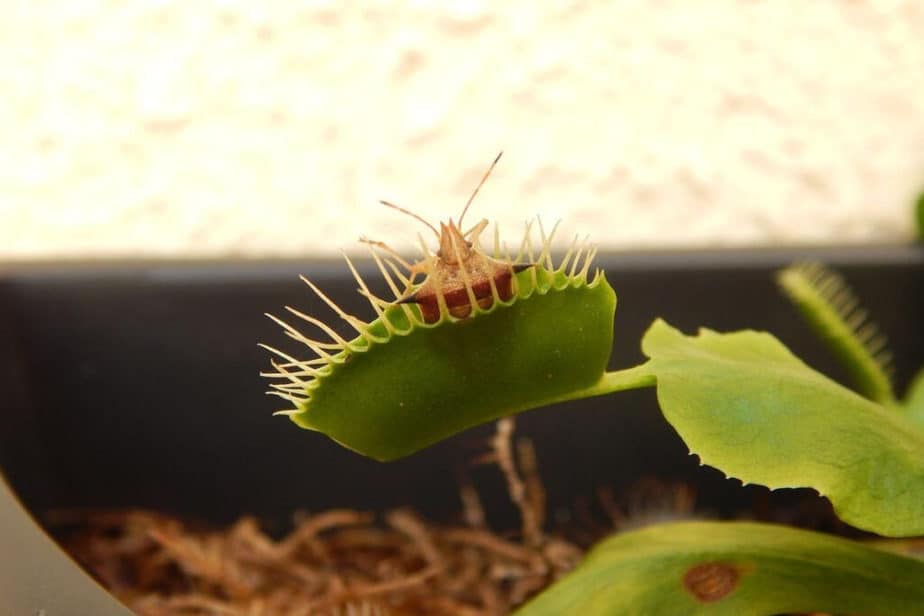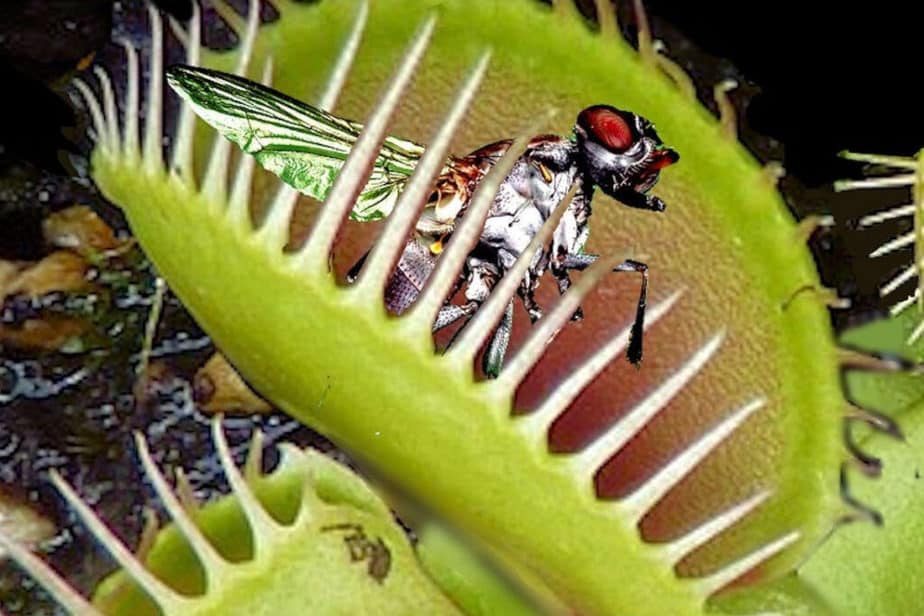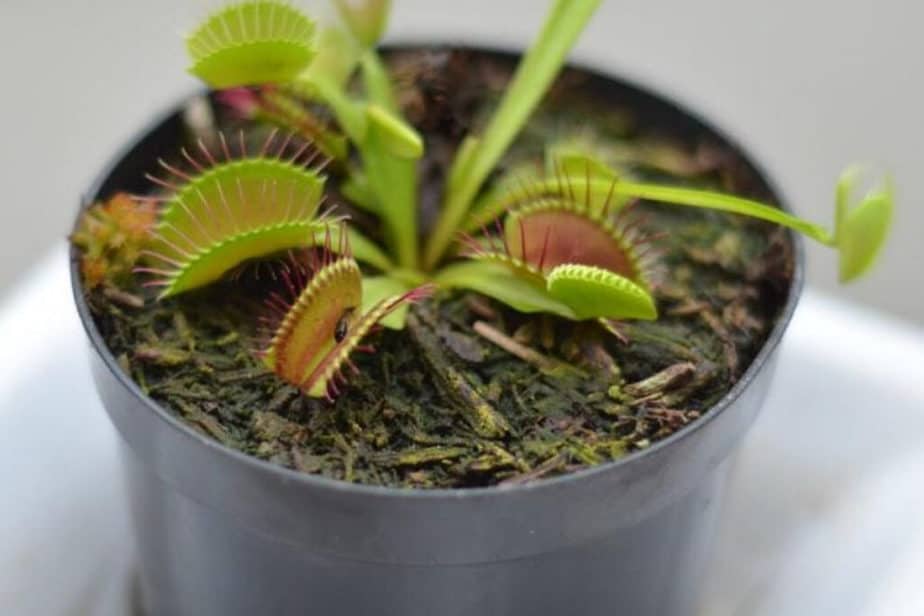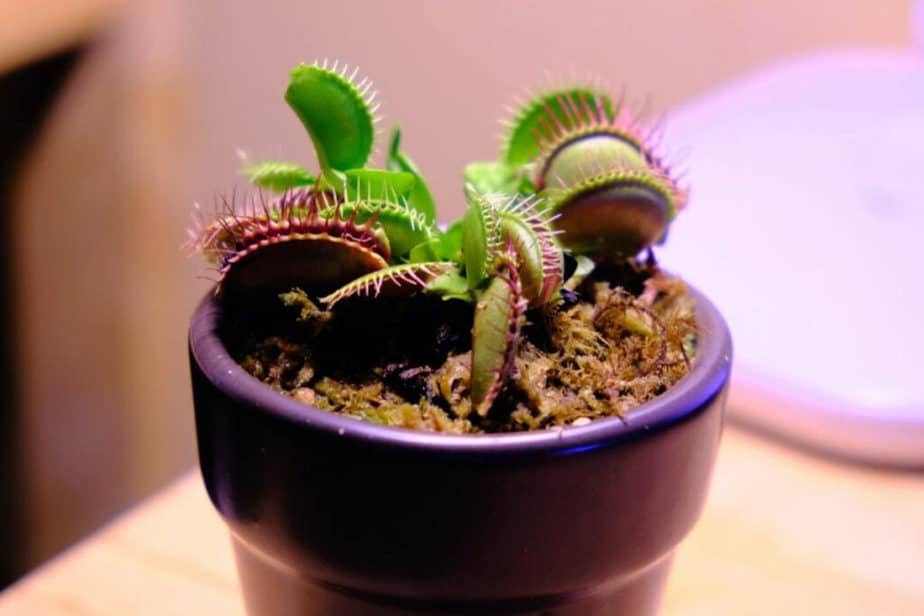Overfeeding a Venus Flytrap is nearly impossible because the traps close up after being fed. However, if you feed too many bugs, they can destroy the traps and cause the plant to die.
Venus flytrap care isn’t too difficult, but feeding bugs to them and whether or not they can eat too much is a common question.
We’ll explore this topic further as we provide you with the proper guides for feeding both indoor and out door Venus Flytraps.
Can You Overfeed A Venus Flytrap?
There is debate about whether you can overfeed a Venus Flytrap. Some people think that you can overfeed a plant, but others do not.
The answer is Yes, overfeeding Venus fly traps can happen..
It’s possible to overfeed them bugs that are too big to break down quickly, but if they’re getting enough light and water, they should be fine. The ideal bug size is 1/3 of the trap’s size. Bugs that are too big might not break down completely, and could eventually rot.
Venus flytraps are carnivorous plants that eat insects. They close when they get full, and then stay closed until they finish eating. Trying to feed them a lot of bugs them doesn’t make them grow any faster or bigger.
When feeding your Venus Flytraps, make sure to feed each trap separately, because the nutrients are shared across all the traps. There’s no need to feed all the traps together.
Don’t put multiple insects into one trap at once either. A Venus fly trap feeding on too much food can cause problems and lead to a rotting plant, that is bad for your garden.
Venus flytraps are carnivorous plants that use stinging hairs to capture prey. Less is more when it comes to how often to feed Venus fly traps.
Given the Venus flytrap’s ability to hold onto nutrients for long periods of time, it’s best to be cautious when feeding them. Therefore, it’s better to underfeed them rather than overfeed them, but really, you should be trying to feed them appropriately. However, they are best off eating less than eating too much.

What Happens If You Feed A Venus Flytrap Too Much?
The Venus flytrap uses its enzymes to break down food into smaller pieces. This makes the food easier to digest. Bugs get caught in traps made by plants, but if they stay there for too long, the bugs will rot, causing the trap to rot.
When a Venus fly trap closes, it will digest the soft parts of the insect. This makes sense because the Venus fly trap doesn’t eat insects whole.
Traps are living creatures that can be used as weapons. Their lifespan is limited by how much food they eat. Over-eating them causes them to waste energy and die early.
Plants need to be fed regularly. Some plants may need more than others. When you feed your plants, make sure to use fertilizer or compost that doesn’t contain any chemicals. Repotting your plants is also important.
How Often Should I Feed My Venus Flytrap?
Traps should be fed one insect every 2-4 weeks. Each single trap feeding on one insect per month will be enough nutrition for a plant to break down and be nourished. The traps will take 1-2 weeks to digest bugs.
A large Venus flytrap needs more food than a smaller one. Feeding two traps together ensures that they get enough nutrients.
If the traps are open, it’s best not to stimulate them to close. The plant will spend a lot of energy closing and opening, which may cause issues with them feeding in the future. Allow them to open and close naturally.
Venus flytraps close up at night and hibernate during winter. They store energy in order to grow stronger. When they’re fed properly, they’ll die too. New traps will grow in their place if there aren’t enough old ones left.
Why Do Venus Flytraps Consume Bugs?
Venus Flytraps are native to the eastern part of the U.S. They grow in wet areas near rivers and streams. They use sunlight to trap insects. They also use the sun to help them grow. They eat bugs and other small creatures.
Venus flytraps need insects to eat, but they also need sunlight. Plants that don’t get enough light won’t grow properly. Insects help Venus flytraps thrive because they provide nutrients and energy. When you feed your plant, you’ll see a noticeable difference in growth.
- Related article: Venus Flytrap Sizes

What Should I Feed My Venus Flytrap?
Venus Flytraps are carnivorous plants, but they don’t eat any meat. They should only eat small bugs. Their prey must be alive or rehydrated. Bugs are the only thing they should be eating.
Venus flytraps use their sticky tentacles to catch prey. If the bugs aren’t alive, you’ll need to trigger the trap hairs to help encourage the traps to close.
Some of the insects that Venus flytraps eat include flies, crickets, spiders, bloodworms, mealworms, and some beetles. Some ants are too small for them even to notice in their trap.
There is also some evidence that certain ants may contain a chemical which is toxic to a Venus flytrap. Aphids are common houseplant pests, but they’re too small to digest for traps.
Traps are used to catch prey. Caterpillars and stronger beetles can eat their way out of traps before they can break down the prey. Grasshopper babies are smaller than adults, and they can escape before the traps fully close.
Feeding your Venus flytraps with anything other than bugs is not recommended. Mealworms and bloodworms may not be good for your Venus flytrap if they’re being sold as part of fish food. There could be additives added to them. Human food and pet food are not good for your plants either.
How Long Can A Venus Flytrap Go Without Food?
A Venus flytrap can survive 1 to 2 months without food. After that time period, the traps will begin to wilt and die. If you continue to leave them without food, they will eventually dry up and die. It’s rare this will happen though as they will usually catch the occasional bug outdoors. When grown indoors, you may need to help feed them an insect.
You don’t need to feed Venus flytraps often. They’re pretty self-sufficient when it comes to eating. But indoors, they probably won’t get enough food to be healthy.
Venus Flytraps are carnivorous plants that eat insects for their nutrients. They don’t use fertilizers, so the sunlight, water, and bugs are what keep them growing.
When the Venus Fly Trap is in its dormant phase, it doesn’t need to eat during the winter months. However, you should make sure that its conditions are right, including lowering the temperature and gradually decreasing the amount of light.
Plants are dormant during winter because they need less water and sunlight. They store nutrients inside their roots and plants, so they won’t starve if they’re not fed. Some plants may die, but new ones can grow back.

Can You Feed Venus Flytraps Dead Bugs?
Yes, you can feed dead bugs to your Venus flytraps. The traps will still respond to the smell of the decaying bugs and break them down.
Make sure the dead bugs are clean and relatively fresh. Moldy or rotten bugs will harm the plant.
How Many Bugs Does a Venus Flytrap Eat?
The average Venus flytrap eats hundreds of bugs in its lifetime. They usually live for about 20 years and each month they’ll eat a few bugs across its numerous traps.
What Can a Venus Flytrap Eat Besides Bugs?
A Venus flytrap doesn’t eat anything other than bugs. Everything it can eat is within the bug category, but that does offer a wide variety. The Venus flytrap can eat ants, flies, fruit flies, grasshoppers, crickets, spiders, moths, wasps, mealworms, and more.
Feeding Indoor Venus Flytraps
People grow Venus flytraps all over the globe. Many times, the outdoor environment isn’t suitable for them. So, it makes sense to house them inside. But, it is difficult for Venus Flytraps to catch their prey indoors. You’ll need to feed bugs to your plant manually, making sure it gets sufficient amounts of nutrition.
Indoors, you’ll want to give the Venus flytrap some sort of protein source. Protein helps plants grow and develop. Insects are high in protein, so they’re perfect for your plant.
Feeding Outdoor Venus Flytraps
Outdoor plants do not need much attention or feeding. You should only feed them when they aren’t looking well and unfed. Feed them a few small insects and see if that helps the plant.
Don’t feed your plants too much though. Overfeeding them can harm them.
When Not To Feed a Venus Flytrap
You shouldn’t feed your plant if it’s catching plenty of bugs on it’s own or if it’s just been repotted.
Flowers are beautiful, but they also need water. Plants that are wilted or droopy are not getting enough water. You should focus on watering them more often than feeding them.
If you see the Venus flytrap is flowering, there’s also no need to feed them. There’s also no need to feed it if it’s during the dormancy period.

Fertilizing Venus Flytraps
There’s usually no need to add extra fertilizer because it gets its nutrients from the bugs. But, if you notice any changes in the color of the leaves, then you might consider fertilizing them.
There is liquid plant food drops for Venus flytraps and other carnivorous plants that can be used. Feed the traps directly with drops. Don’t add the food to the soil. This could cause the soil to become acidic and the plant wouldn’t like that.
Overfeeding Venus Flytraps Final Thoughts
Overfeeding a Venus flytrap is technically possible and very dangerous for the plant. Don’t feed every trap at the same time and your plant should do just fine.
Here are some other articles that you may be interested in:




